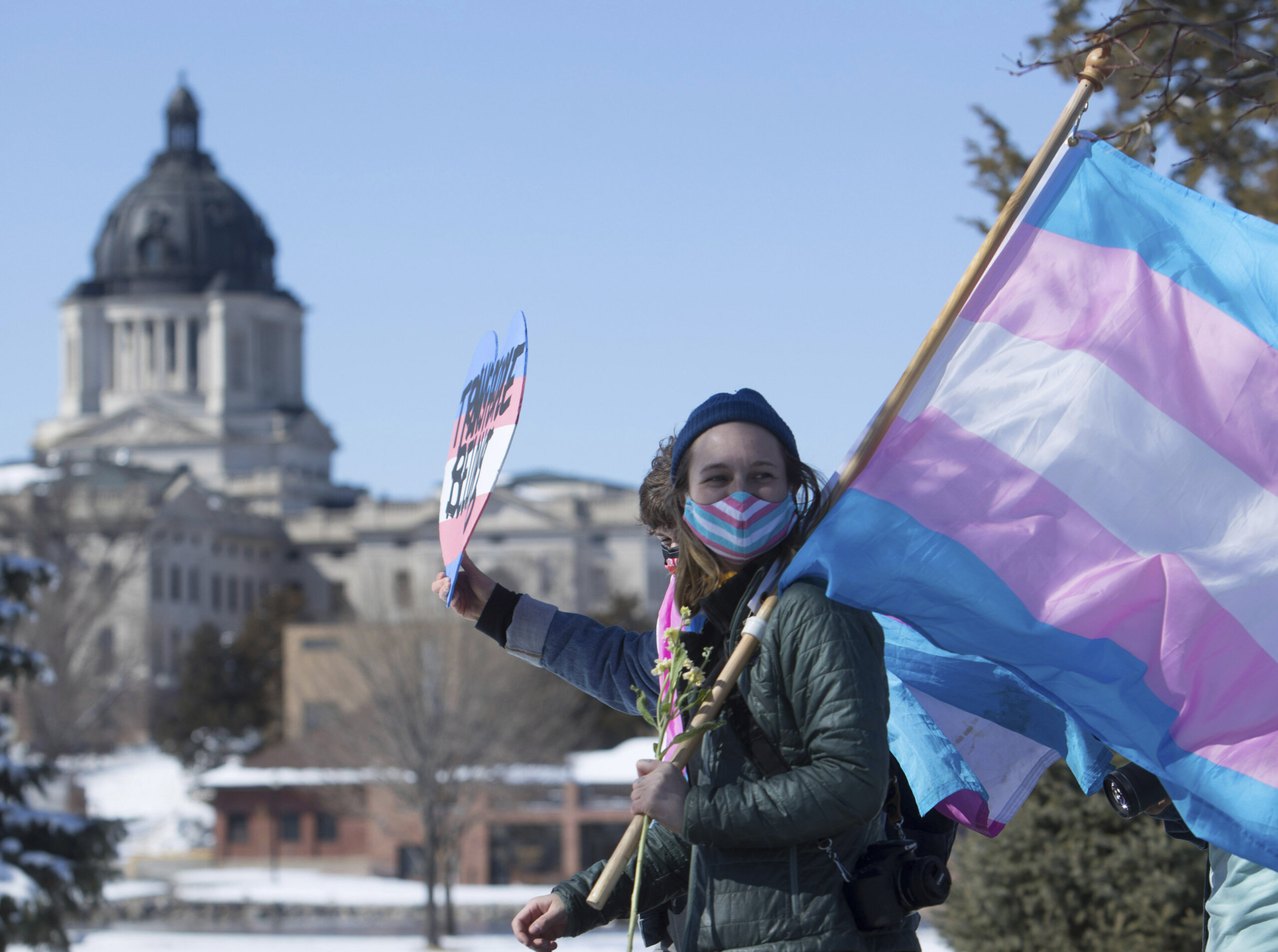Where are all of these anti-trans bills coming from?
In recent months, it seems like a different U.S. state has introduced new legislation targeting trans athletes, trans kids or trans health care every day. In total, more than 100 pieces of unique anti-trans legislation have been introduced in the U.S. since January, and the fight is continuing in state legislatures daily.
One proposed bill in Minnesota would make it a crime for trans girls to play women’s sports. Another in Texas would categorize gender-affirming health care as child abuse and could have trans kids taken away from their parents. Others target puberty blockers, bathrooms, birth certificates and other key fundamental rights for trans people in the United States.
And despite a recent PBS NewsHour/NPR/Marist poll showing that 70 percent of Americans surveyed opposed these bills, they’re still being passed.
It’s grim. It’s horrifying. And yet, unfortunately, it’s nothing new. While these dangerous bills—and the speed with which they’ve rolled out across the U.S.—may seem sudden, new or spontaneous, experts warn that the dangerous ideas behind them are not as new as they may seem.
The road to these bills in 2021 is far from short. Here’s what you need to know.
What is an anti-trans bill?
Any piece of legislation that hinders, suspends or harms the rights of trans people is anti-trans. The particular legislation making headlines in 2021, however, has been focused largely on the youngest and most vulnerable people: Trans kids.
Many of these bills target participation in gender-segregated sports. One Florida bill proposes invasive “genital screening,” while another in Texas suggests taking kids away from parents who affirm their gender. Others take aim at trans health care and, in particular, access to puberty blockers and hormone replacement therapy for trans youth.
Why trans kids?
Many Republican lawmakers behind these bills have decried health care like puberty blockers as “untested” and trans kids as a “new phenomenon” we don’t fully understand.
But “that is simply untrue,” says Jules Gill-Peterson. “We exactly know what it’s like for children to transition because they’ve been doing it for 50 to 70 years—as far back as there’s been any trans medicine for them.”
Gill-Peterson is an associate professor of english and gender, sexuality, and women’s studies at the University of Pittsburgh. Her 2018 book, Histories of the Transgender Child, looks at the decades-long history and precedent of trans children and their access to medical care.
“As far back as there’s any kind of medical possibility for transition, we’ll see kids, remarkable kids,” Gill-Peterson says.
She adds that these new bills are taking aim at trans kids because, in many ways, targeting the most vulnerable populations is an easy win for the right.
“The bills themselves target really substantial material issues like education and health care—things that affect your quality of life, or even your ability to survive,” Gill-Peterson says.
Where did all of these bills come from?
These bills aren’t new. In fact, the United States went through a similar wave of anti-trans bathroom bills back in 2016 during Donald Trump’s presidential campaign and even after his eventual election as president. It also happened to be a year after legalization of same-sex marriage throughout the U.S.
But these bills were in the works before even that. The origins of the “bathroom bill” can be traced back to Houston, Texas, in 2014, where city council attempted to pass anti-discrimination policy that protected trans folks. That bill ended up failing, largely because conservative groups whipped up a fervour over the possibility of trans people using their correct washrooms and the myth that cis men would sneak into women’s washrooms as a result.
“We exactly know what it’s like for children to transition because they’ve been doing it for 50 to 70 years—as far back as there’s been any trans medicine for them.”
Then came Charlotte, North Carolina, where a similar non-discrimination law was repealed thanks to concerns over bathrooms. State legislators saw the success of the Charlotte bill and brought forth the first of America’s infamous “bathroom bills” in 2016. This legislation banned local non-discrimination laws involving LGBTQ2S+ people and gender identity, effectively prohibiting trans people from using the bathroom that best corresponded to their gender identity.
Dozens more dangerous bathroom bills across the U.S. followed, as right-wing and religious groups shifted their focus from the battle over marriage equality to the battle over trans rights, in what the New York Times editorial board called “bathroom hysteria.” Many of these bills displayed the exact same ideas, phrasing and language, suggesting a co-ordinated effort to get them passed.
“It would be surprising if legislators across the country all had the same idea at the same time,” Cathryn Oakley, senior legislative counsel for Human Rights Campaign, told Mother Jones at the time.
Legislators behind the bathroom bills in Kansas even confirmed to Mother Jones that they based their own legislation off existing templates from right-wing groups and other states.
How do you write the modern anti-trans bill?
Surely this sort of co-ordinated campaign against trans rights doesn’t still happen, right? Unfortunately, like a teenager building a resumé—but way more horrifying—there’s actually still a template for it. And that template is now being applied to the recent bills focusing on sports and health.
“These have been built almost like in a factory assembly line,” Gill-Peterson says. “They don’t come out of a response to real problems.”
Many of these recent bills were not conceived by the lawmakers putting them forward, but are machinated by conservative and religious third-party groups en masse. These groups develop everything from talking points to the actual wording of the bill itself.
A big group behind these efforts back in 2016—and still today—is a network of lawyers called the Alliance Defending Freedom (ADF). The group’s purported core issues include religious freedom, “sanctity of life” and marriage and family. Read: Abortion bills, marriage equality and trans rights.
The ADF has been doing this work since 2014, when they sent letters to school districts across America pushing for single-stall washrooms for trans kids instead of inclusive ones. The group also brought those ideas to state legislatures and helped sow the seeds for the notorious “bathroom bills” of the 2010s.
Other groups, like the Heritage Foundation and the Family Research Council, have also worked on anti-LGBTQ2S+ bills and anti-abortion bills in the past.
“They’re the ones creating templates [for these bills],” Gill-Perterson says. “They’re the ones educating state legislators, offering them the language and talking points, and showing up to testify in state hearings.”
In 2019, Idaho passed two bills that Gill-Peterson calls the “prototypes” of what we’re seeing across the U.S. now: One bill banned trans girls and women from participating in womens’ sports; the other would make it illegal for trans people to change gender markers on their Idaho birth certificates.
Much like the situations in Houston and North Carolina back in 2014 and 2016, these bills served as an ideological—and literal—jumping off point for a wave of similar legislation.
Why are there so many anti-trans bills in 2021?
Gill-Peterson attributes the surge in anti-trans bills to several factors. The increasing public visibility of trans kids and their relative vulnerability makes them easy targets for legislation like this. These bills prey on the fears of parents of cis kids and people who don’t understand that trans kids—and their access to medical care—have been around for a long time.
“We’ve seen this kind of drift toward politicizing trans people, attacking trans people, as a platform of right-wing politics,” Gill-Peterson says.
Gill-Peterson says the bills are a natural progression from the attitudes built into the bathroom bills or opposition to same-sex marriage. But she also cautions against assuming these bills are simply about restricting trans rights or some sort of ideological culture war from the right.
“I think there is also this broader right-wing agenda that [doesn’t have] with identity politics or culture wars,” she says. “[It has] much more to do with the state abdicating its responsibility to educate people and to provide public health care and welfare and other kinds of benefits that we would expect the state to provide.”
These bills are just the latest manifestation of a decades-long co-ordinated political effort. Many of the people behind them, Gill-Peterson says, don’t personally take issue with trans people, but are bringing forward these bills because they’re the next in the political process.
“Some of this has to do with, I think, the unfinished business of same-sex marriage in the U.S. in particular,” she says. The fight for marriage equality in the U.S, while a victory for gay, lesbian and bisexual folks, largely left trans people out of the conversation.
With same-sex marriage affirmed in the Supreme Court, right-wing groups and legislators had to redirect their fight—and trans people’s rights were next in line.
Where do we go from here?
Gill-Peterson says it’s important to continue to fight and call out these bills, but also to watch for the seeds of a future “intensification” of transphobic and homophobic legislation in other jurisdictions. She points to legislation like Alberta’s Bill 24, which passed in 2019 and made it legal to inform parents if their child joins a gay-straight alliance.
“That’s already very dangerous because it’s making children vulnerable,” she says. “Every time that sort of needle moves a little bit further in the realm of discrimination and state attack, it just sets [us] up for more.”
She pointed to the first wave of U.S. bills focusing on trans participation in sports and how quickly that escalated to subsequent bills involving things like “genital inspection.” Even over the course of 2021, bills have become more invasive, more outlandish and more threatening to basic rights, yet they continue to pass in state legislatures.
The unrelenting wave has left many advocates on the back foot.
“A lot of times we find ourselves on the defensive, like we’re reacting to these bills, to these attacks and to these proposals,” she says.
Gill-Peterson says that while we must fight the bills individually, fighting for broad causes that include trans rights—such as prison reform and health care reform—is vital. LGBTQ2S+ advocates and allies have to see the forest, not just the trees, and shore up protections down the road.
“We’ve been through so much in the last five years. We’ve had to fight so many times, just for basic basic human rights,” Gill-Peterson says. “But I think this moment requires more of us to be bolder, to ask for more and to see trans struggles as interconnected in struggles for racial justice, economic justice, Indigenous justice and health care justice.”


 Why you can trust Xtra
Why you can trust Xtra


